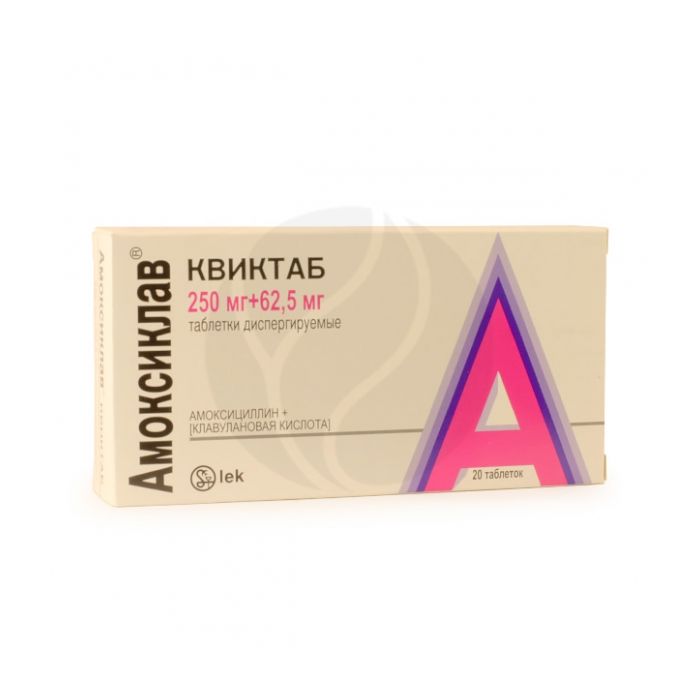Amoxiclav Kviktab dispersible tablets 250 + 62.5mg, No. 20
Expiration Date: 05/2027
Russian Pharmacy name:
Амоксиклав Квиктаб таблетки диспергируемые 250+62,5мг, №20
Treatment of infectious and inflammatory diseases caused by sensitive pathogens: lower respiratory tract infections (bronchitis, pneumonia, pleural empyema, lung abscess);
ENT infections (sinusitis, tonsillitis, otitis media);
infections of the genitourinary system and pelvic organs (pyelonephritis, pyelitis, cystitis, urethritis, prostatitis, cervicitis, salpingitis, salpingo-oophoritis, tubo-ovarian abscess, endometritis, bacterial vaginitis, septic abortion, postpartum sepsis, pelvioperitonitis, chancroid soft);
infections of the skin and soft tissues (erysipelas, impetigo, secondarily infected dermatoses, abscess, phlegmon, wound infection);
osteomyelitis;
postoperative infections.
Prevention of infections in surgery.
The dosage regimen is set individually depending on the severity of the course and localization of the infection, the sensitivity of the pathogen.
Dispersible tablets light yellow to yellow in color, round, with brown blotches, and with a hemispherical depression on both sides and engraved 'SN57' on one side.
1 tab. amoxicillin trihydrate 287 mg,
which corresponds to the content of amoxicillin 250 mg
potassium clavulanate 74.4 mg,?
which corresponds to the content of clavulanic acid (in the form of potassium clavulanate) 62.5 mg
Excipients: crospovidone - 19.7 mg, silicon dioxide - 4.9 mg, sweet orange flavor - 19.7 mg, microcrystalline silicon-containing cellulose - 49.2 mg, sucralose - 2.7 mg, sodium stearyl fumarate - 14.3 mg, iron (III) oxide yellow (E172) - 0.6 mg, mannitol - 167.4 mg.
hypersensitivity to drug components;
a history of hypersensitivity to penicillins, cephalosporins and other beta-lactam antibiotics;
a history of cholestatic jaundice and / or other liver dysfunction caused by taking amoxicillin / clavulanic acid;
infectious mononucleosis and lymphocytic leukemia;
For dispersible tablets AmoxiclavЃ Kviktab additionally
children under 12 years old or weighing less than 40 kg.
phenylketonuria;
With care: a history of pseudomembranous colitis, gastrointestinal diseases, liver failure, severe renal dysfunction, pregnancy, lactation, simultaneous use with anticoagulants.
Pharmacological action
It is a combined preparation of clavulanic acid (beta-lactamase inhibitor) and amoxicillin. The drug inhibits the formation of the wall of microorganisms, acts bactericidal. This drug is active against aerobic gram-negative microorganisms and aerobic gram-positive microorganisms.
Overdose
There are no reports of death or life-threatening side effects due to drug overdose.
Symptoms: in most cases - gastrointestinal disorders (abdominal pain, diarrhea, vomiting), possibly agitation, insomnia, dizziness, in rare cases - seizures.
Treatment: in case of an overdose, the patient should be under medical supervision, treatment is symptomatic.
In the case of a recent intake (less than 4 hours) of the drug, it is necessary to wash the stomach and prescribe activated charcoal to reduce absorption. Removed by hemodialysis.
special instructions
During the course of treatment, it is necessary to monitor the state of the function of the hematopoietic organs, liver and kidneys.
In order to reduce the risk of side effects from the gastrointestinal tract, the drug should be taken with meals.
The development of superinfection is possible due to the growth of microflora insensitive to it, which requires a corresponding change in antibiotic therapy.
May give false positive results for glucose in urine. In this case, it is recommended to use the glucose-oxidative method for determining the concentration of glucose in the urine.
In patients with hypersensitivity to penicillins, cross-allergic reactions with cephalosporin antibiotics are possible.
Drug interactions
Antacids, glucosamine, laxatives, aminoglycosides slow down and reduce absorption; ascorbic acid enhances absorption.
Bacteriostatic antibiotics (macrolides, chloramphenicol, lincosamides, tetracyclines, sulfonamides) have an antagonistic effect.
Increases the effectiveness of indirect anticoagulants (suppressing the intestinal microflora, reduces the synthesis of vitamin K and the prothrombin index). With the simultaneous administration of anticoagulants, it is necessary to monitor the indicators of blood clotting.
Reduces the effectiveness of oral contraceptives, drugs, in the process of metabolism of which PABA is formed, ethinyl estradiol - the risk of bleeding 'breakthrough'.
Diuretics, allopurinol, phenylbutazone, NSAIDs and other drugs that block tubular secretion increase the concentration of amoxicillin (clavulanic acid is excreted mainly by glomerular filtration).
Allopurinol increases the risk of skin rashes.

